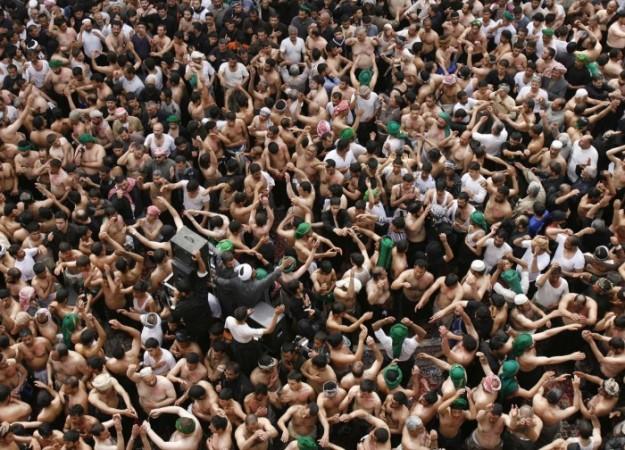
Massive protests have broken out in the Pakistan-occupied Gilgit-Baltistan region over the arrest of a Shia cleric under Pakistan's reinforced blasphemy laws. The protests are said to be the largest that the region has ever seen, with slogans of "Chalo, chalo Kargil chalo" rending the air. The Gilgit protests were sparked by the arrest of a Shia cleric named Agha Baqir al-Hussaini on charges of blasphemy. Protests erupted in Gilgit, Pakistan-occupied Gilgit-Baltistan, and Skardu, and were organized by Shia Muslims who demanded the release of the cleric and the opening of the Karakoram Highway. The arrest of Agha Baqir al-Hussaini was made under Pakistan's strengthened blasphemy laws, which have been a source of controversy and criticism. These laws have been used to target individuals from various religious communities, including Christians, Hindus, Ahmadi Muslims, Sunni Muslims, and Shia Muslims. The protests in Gilgit and Skardu reflect the discontent and anger among Shia Muslims over the arrest of their religious leader.
The situation in Gilgit remains tense as the protests continue. The initial protests started on August 20 when Sunni organizations launched a rally demanding the arrest of the accused Shia cleric. Gilgit-Baltistan is a region located in the northern part of Pakistan, bordering China, India, and Afghanistan. It's a geographically and strategically important area known for its stunning mountain landscapes, including parts of the Himalayas, Karakoram Range, and Hindu Kush Range. Gilgit-Baltistan is a semi-autonomous administrative region within Pakistan. Historically, its status has been a subject of dispute due to its location near the borders of India and China. India claims Gilgit-Baltistan as part of the larger Jammu and Kashmir region. The region is governed by a Chief Minister and a legislative assembly, which was established in 2009. However, Gilgit-Baltistan does not have representation in the Pakistani National Assembly or Senate. Instead, it has a limited representation in the Pakistani Kashmiri assembly known as the Azad Jammu and Kashmir Legislative Assembly. Gilgit-Baltistan is ethnically and culturally diverse, with various ethnic groups such as Shina, Balti, Burusho, and others residing there. These groups have their own languages, traditions, and customs.
The Pakistani government has been investing in infrastructure development in Gilgit-Baltistan, including road networks, hydropower projects, and tourism initiatives. The China-Pakistan Economic Corridor (CPEC), a major infrastructure project, includes several projects in the region, aiming to improve connectivity with China's Xinjiang region and the rest of Pakistan. Due to its geographical location, Gilgit-Baltistan holds strategic significance for both Pakistan and neighbouring countries. The region borders the disputed Line of Control (LoC) with India-administered Jammu and Kashmir and the China-India border. Residents of Gilgit-Baltistan have historically sought greater political rights and representation within Pakistan. There have been discussions about granting the region provincial status, which would provide more autonomy and representation in Pakistan's national institutions. The region faces challenges related to economic development, healthcare, education, and infrastructure. Some locals also express concerns about the lack of political representation and the region's semi-autonomous status.
The Shia-Sunni split in Islam has its roots in the early days of the religion, stemming from a disagreement over the rightful successor to the Prophet Muhammad. The split occurred after the death of the Prophet in 632 CE, when some Muslims believed that the leadership should pass to Ali ibn Abi Talib, the cousin and son-in-law of Muhammad, while others believed it should go to Abu Bakr, a close companion of the Prophet. The Shia, also known as Shiites, are followers of Ali and believe that leadership should remain within the Prophet's bloodline, specifically through the Imams who they consider to be divinely appointed. They make up a significant minority within the Muslim world, with the largest populations found in Iran, Iraq, Bahrain, and Lebanon.
On the other hand, the Sunni majority believes that leadership should be chosen through consensus and that the caliphate can be held by any qualified individual. Sunnis comprise majority of the Muslim population worldwide and follow the teachings of the Prophet Muhammad and the four righteous caliphs who succeeded him. The historical divide between Sunni and Shia Muslims has led to ongoing sectarian tensions and, in some cases, violence. These tensions have been fuelled by various factors, including regional power struggles, political conflicts, and differing interpretations of Islamic teachings.

Sectarian violence between Sunni and Shia communities has occurred in several countries, including Iraq, Syria, Lebanon, Pakistan, and Bahrain. This violence has taken the form of targeted attacks, bombings, and even full-scale civil wars. Extremist groups, such as ISIS and Al-Qaeda, have also exploited the sectarian divide to further their own agendas. In Iraq, the fall of Saddam Hussein's Sunni-led regime in 2003 and the subsequent power vacuum created a sectarian power struggle between Shia and Sunni factions. This conflict has resulted in widespread violence and instability in the country. In Syria, the civil war that began in 2011 has also been heavily influenced by sectarian tensions. The government of President Bashar al-Assad, who belongs to the Alawite sect (an offshoot of Shia Islam), has faced opposition from Sunni-majority rebel groups.
It is important to note that the majority of Shia and Sunni Muslims coexist peacefully and do not engage in sectarian violence. However, the actions of extremist groups and political conflicts have often exacerbated tensions between the two communities. Efforts to promote interfaith dialogue and bridge the divide between Sunni and Shia communities have been ongoing, both within Muslim-majority countries and at an international level. Organizations and religious leaders from both sects have called for unity and peaceful coexistence, emphasizing the shared values and beliefs of Islam. India is home to both Sunni and Shia religious institutions, and both sects have their own mosques, madrasas (Islamic religious schools), and religious organizations. The country has notable Sunni institutions like Aligarh Muslim University and Jamia Millia Islamia, as well as Shia institutions like Imambara and Imambara Ghufran Ma'ab in Lucknow.
India has a diverse Muslim population, with regional, cultural, and linguistic differences playing a role in shaping interfaith dynamics. In some regions, such as Lucknow, there have been instances of Sunni-Shia conflicts, but these are localized and not indicative of the broader relationship between the two sects in the country. Shia-Sunni relations in India have generally remained cordial, with instances of conflict being relatively rare. India has a significant Muslim population, and both Sunni and Shia Muslims coexist in various parts of the country. While there have been occasional tensions and localized conflicts between the two sects, overall, the relationship between Sunni and Shia Muslims in India has not been marked by widespread sectarian violence.
[Disclaimer: This is an authored article by Arshia Malik. Views expressed are author's own.]









